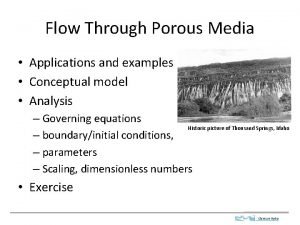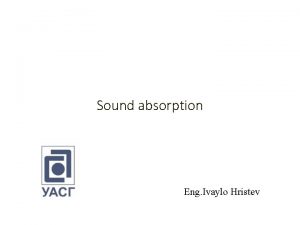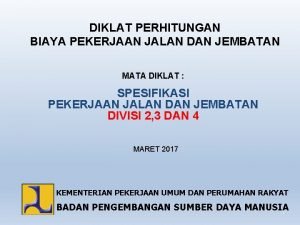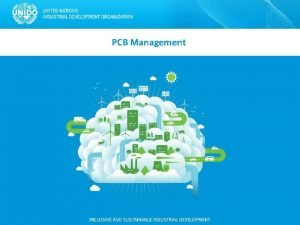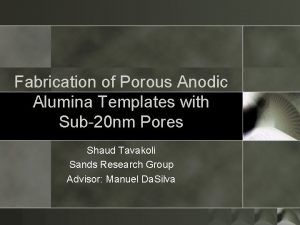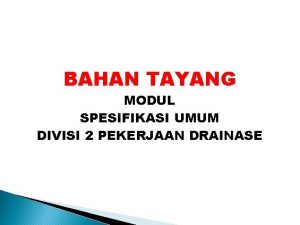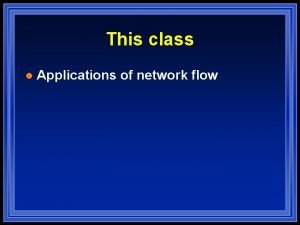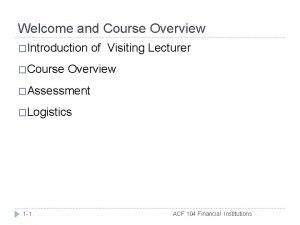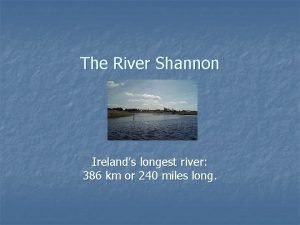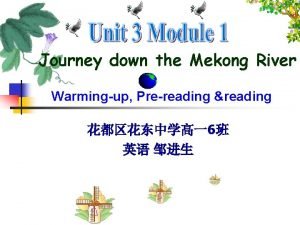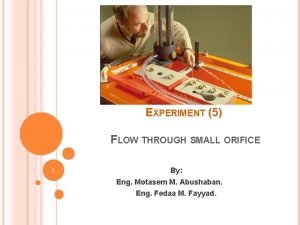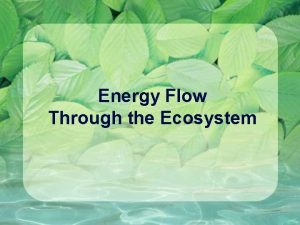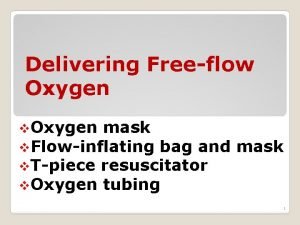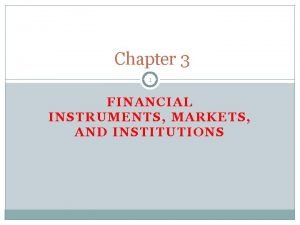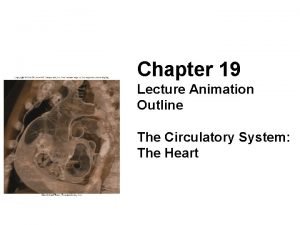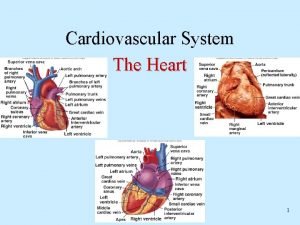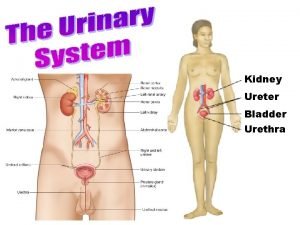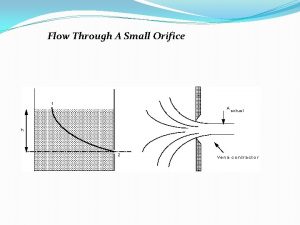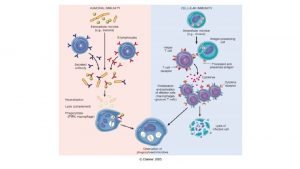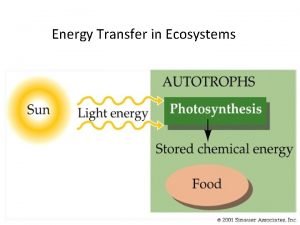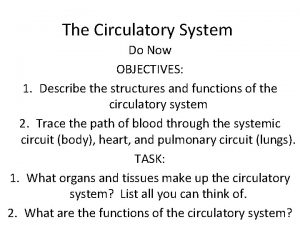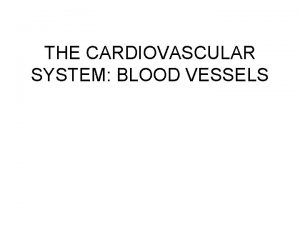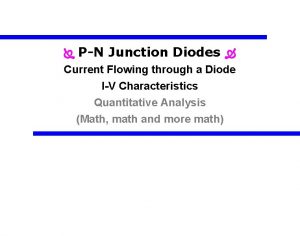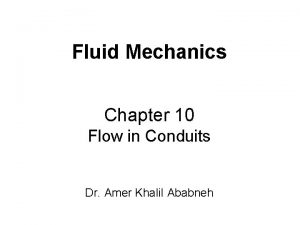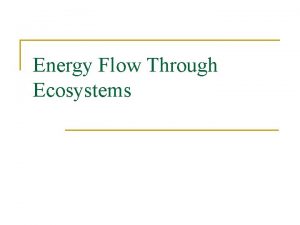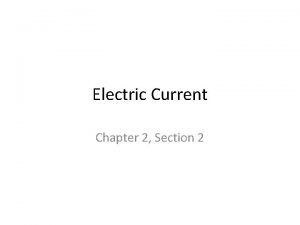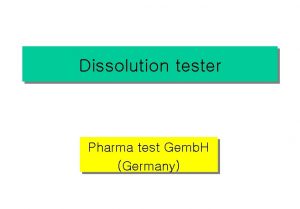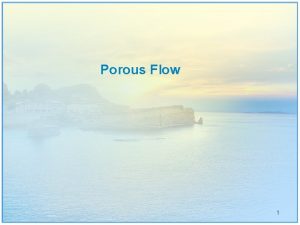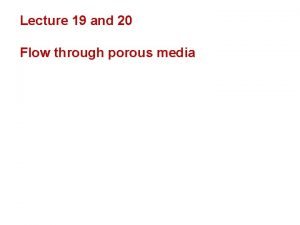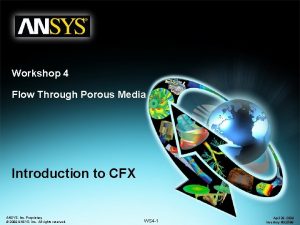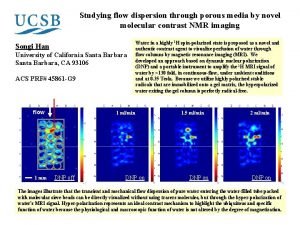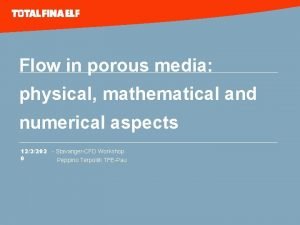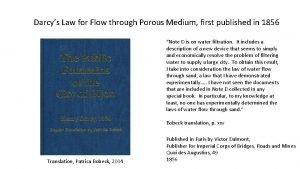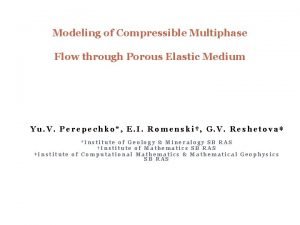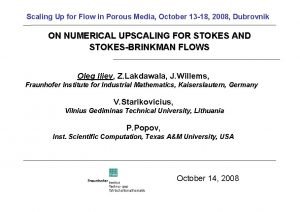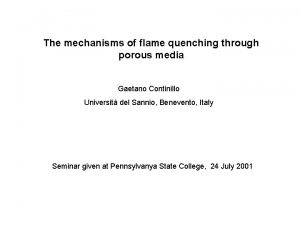Flow Through Porous Media Applications and examples Conceptual





![Two-way porous media flow in plants Sap flow meter [Kent, 2000] Water with inorganic Two-way porous media flow in plants Sap flow meter [Kent, 2000] Water with inorganic](https://slidetodoc.com/presentation_image_h/8bddff2e1d4d5c317294d0bf882fa7d8/image-6.jpg)






















![Properties r: fluid density [M/L 3] k: permeability [L 2] g: gravity acceleration [L/T Properties r: fluid density [M/L 3] k: permeability [L 2] g: gravity acceleration [L/T](https://slidetodoc.com/presentation_image_h/8bddff2e1d4d5c317294d0bf882fa7d8/image-29.jpg)


![Units Default is SI: m, kg, s, Pa Write with square brackets: 23[m] 12[Pa] Units Default is SI: m, kg, s, Pa Write with square brackets: 23[m] 12[Pa]](https://slidetodoc.com/presentation_image_h/8bddff2e1d4d5c317294d0bf882fa7d8/image-32.jpg)












- Slides: 44

Flow Through Porous Media • Applications and examples • Conceptual model • Analysis – Governing equations Historic picture of Thousand Springs, Idaho – boundary/initial conditions, – parameters – Scaling, dimensionless numbers • Exercise Clemson Hydro

Sand Filter Trap material in water Industrial filter Home water filter Sintered nickel filter media Sand filter for a swimming pool http: //www. thermaxindia. com/Water-and-Waste-Solutions/Systems-and-Solutions/Filtration. aspx http: //sti. srs. gov/fulltext/ms 2002431. html http: //www. dgssupply. dk/dgs-info/irrigation. html http: //www. poolcenter. com/filter_poolstor_pentair. htm Clemson Hydro

High Efficiency Sand Filter Trap material in water, reduce clogging http: //www. ameriwater. com/products/industrial/cooling-tower-filtration/ Clemson Hydro

Darcy’s Experiment Design Water Filter Clemson Hydro

Plants Nutrients, heat, growth Cross-section of a monocot root, showing cortex, pith and vascular tissue. Image courtesy of Wendy Paul Water flow from soil to atmosphere through a tree Section through woody tissue, showing xylem tracheids. Image courtesy of Roberta Farrell. http: //ugt-online. de/en/produkte/oekologie/saftfluss-und-wasserpotenzial/xylemflusssensor-hfd. html http: //sci. waikato. ac. nz/farm/content/plantstructure. html http: //serc. carleton. edu/eslabs/weather/1 d. html Clemson Hydro
![Twoway porous media flow in plants Sap flow meter Kent 2000 Water with inorganic Two-way porous media flow in plants Sap flow meter [Kent, 2000] Water with inorganic](https://slidetodoc.com/presentation_image_h/8bddff2e1d4d5c317294d0bf882fa7d8/image-6.jpg)
Two-way porous media flow in plants Sap flow meter [Kent, 2000] Water with inorganic nutrients flows from roots to leaves through xylem, sugar produced in leaves flows down the phloem. http: //kids. britannica. com/elementary/art 66141/Cross-section-of-a-tree-trunk Clemson Hydro

Porous media flow in mammals Many essential processes in biology Lung tissue Aveola pore in lung Pores in kidney tissue Cross-section of aveola. Blood capillaries in dark grey http: //www. scielo. cl/scielo. php? script=sci_arttext&pid=S 0717 http: //www. sciencedirect. com/science/article/pii/S 109564330000218 X 95022009000300024&lng=en&nrm=iso&ignore=. html http: //www. nature. com/pr/journal/v 55/n 2/fig_tab/pr 200444 f 8. html Cast of arterial blood vessels in the kidney Clemson Hydro

Rock and sediment Recovery of important resources • Original void space Photomicrograph of carbonate rock, blue is pore space Photomicrograph of Nubian sandstone Christopher Kendall, 8/17/2005 , http: //strata. geol. sc. edu kendall@sc. edu Beach sand, Rodeo Beach, CA http: //www. msnucleus. org/membership/html/k-6/rc/rocks/3/images/rckr 06. jpg Vesicular basalt, Hawaii meteorites. wustl. edu/id/vesicles. htm Clemson Hydro

Pore space in Sandstone From x-ray tomography 22 percent porosity 7 percent porosity 1 mm Clemson Hydro

3 -D Pore space with computed tomography http: //www. netl. doe. gov/newsroom/labnotes/2010/11 -2010. html Shale Connected pores: red Disconnected pores: green Main flow path: blue Sandstone Connected pores: white Disconnected pores: red Image size: 1. 2 mm Clemson Hydro

Shale SEM CT micron Clemson Hydro

Aquifers and confining units Clemson Hydro

Oil and Gas Reservoirs Interbedded gravel, coarse- and finegrained sand stone Spindletop well, TX http: //www. sjvgeology. org/history/lakeview/spindletop_bg. jpg http: //www. southampton. ac. uk/~imw/Oil-South-of-England. htm Clemson Hydro

Analyze fluid flow through porous media Objective: Determine flux and pressure 1. Conceptual model 2. Governing Equations 3. Boundary Conditions 4. Properties 5. Examples Clemson Hydro

General Concepts • Average properties over REV, REV>>pores continuum • Mass of fluid is conserved • Momentum is conserved Clemson Hydro

Continuum Representative Elementary Volume REV Average the effects of complex pore geometries Clemson Hydro

Average Properties over REV Porosity 1 0 REV Size Use volume average of properties Clemson Hydro

Governing Eqns Problem: Flux and pressure are unknowns. They are what we want to determine. Approach: Two unknowns, need two governing equations 1. Conservation of momentum 2. Conservation of mass Implementation: 1. general expressions first, then tailor them for porous media 2. Start here: Divergence of flux vector plus rate of storage change equals the rate of source production Clemson Hydro

Conservation of Mass r: fluid density F: porosity Se : degree of saturation Storage c = rf. Se Advective Flux No Diffusive Flux Source Governing Clemson Hydro

Conservation of Momentum Use pore only as CV Storage c = rv Advective Flux A= vc= vvr Units of stress or pressure Diffusive Flux Source Governing Clemson Hydro

Slow (laminar) flow with no acceleration or body forces average Gauss’s Theorem Clemson Hydro

Hagen-Pouiselle Law for laminar flow in tube Force balance Substitute into HP Sub into average Clemson Hydro

Darcy’s Law for horizontal flow In terms of hydraulic head Need to include gravity for vertical flow Body force in fluid Need to start from two slides ago and revise. The result is Darcy’s Law is conservation of momentum averaged over the REV Clemson Hydro

Things you need to know to define a process Governing equations Conservation Laws, constitutive equations Define dependant variable(s) Possibly multiple, coupled Boundary conditions Dirichlet, Neumann, Cauchy-type, other; names vary with process Properties Sources Constant Spatially variable (heterogeneous) Temporally variable, controlled externally Temporally variable, coupled to dependent variable Clemson Hydro

Implementation Hydraulic head as dependent variable • Governing Equations – Mass balance – Momentum balance—flow law – Dependent variable • Hydraulic head, h = p/g + z [L] Properties r: fluid density [M/L 3] Ss: specific storage [1/L] k: permeability [L 2] g: gravity acceleration [L/T 2] m: viscosity [M/LT] Source Qm: mass source [M/(L 3 T)] z: upward coordinate [L] u: volumetric flux vector [L/T] Clemson Hydro

Defining Flow through Porous Media Pressure as dependent variable • Governing Equations – Mass balance – Momentum balance—flow law – Dependent variable • pressure, p [M/LT 2] Properties r: fluid density [M/L 3] Ss: specific storage [1/L] k: permeability [L 2] g: gravity acceleration [L/T 2] m: viscosity [M/LT] Source Qm: mass source [M/(L 3 T)] D: upward coordinate [L] u: volumetric flux vector [L/T] Clemson Hydro

Boundary Conditions All external boundaries • Dirichlet (specified head/pressure) h= C 1 • Neumann (specified gradient or flux) n n. u • Cauchy (head dependent flux) n unit vector normal to boundary u flux vector C 1 known function Clemson Hydro

Initial Conditions • • Transient problems Must specify values of c (head or pressure) at t=0. Base on info about the problem, conditions at the start i. c. not needed for steady state. • One strategy is to run a steady state problem and use the results as initial conditions for transient problem Clemson Hydro
![Properties r fluid density ML 3 k permeability L 2 g gravity acceleration LT Properties r: fluid density [M/L 3] k: permeability [L 2] g: gravity acceleration [L/T](https://slidetodoc.com/presentation_image_h/8bddff2e1d4d5c317294d0bf882fa7d8/image-29.jpg)
Properties r: fluid density [M/L 3] k: permeability [L 2] g: gravity acceleration [L/T 2] m: viscosity [M/LT] cs: compressibility [1/P] Hydraulic conductivity Needed for transient models only • Assume properties are constant for basic problems (saturated, locally deformable). • Properties vary as functions of h or p if unsaturated, non-local deformation Clemson Hydro

Fluid Properties Depend on P, T, C, other. Values for standard conditions http: //www. engineeringtoolbox. com/liquids-densities-d_743. html Clemson Hydro

Porous media properties Clemson Hydro
![Units Default is SI m kg s Pa Write with square brackets 23m 12Pa Units Default is SI: m, kg, s, Pa Write with square brackets: 23[m] 12[Pa]](https://slidetodoc.com/presentation_image_h/8bddff2e1d4d5c317294d0bf882fa7d8/image-32.jpg)
Units Default is SI: m, kg, s, Pa Write with square brackets: 23[m] 12[Pa] Can change units system Using units helpful, but not required. Orange color on equation indicates problem with units. • Recommend using SI • Water density: 1000 [kg/m^3]; viscosity: 0. 001 [kg/(m*s)]; g: 981 [m/s^2] • • Clemson Hydro

Examples • • Steady flow between two streams Transient flow to a well Transient flow in a tree Clemson Hydro

Example, flow between two streams What is the hydraulic head and flow between two streams? K=1 E-6 m/s; recharge R=1 E-9 m/s; thickness b=10 m. Qm = R*density/b Stream CH boundary 1000 m Clemson Hydro

Boundary conditions Conceptual model h 1 h 2 b x L b. c. 1: h = h 1 @ x = 0 b. c. 2: h = h 2 @ x = L Clemson Hydro

Use b. c. to solve for constants b. c. 1: h = h 1 @ x = 0 b. c. 2: h = h 2 @ x = L Clemson Hydro

Substitute constants and solve for h Assume L=1000 m, b=25 m Clemson Hydro

Exercise, steady state 1. Determine heads using specified geometry and parameters – Plot heads as color flood, contours – Plot flow vectors, streamlines 2. Include head gradient in stream using h=y*0. 02 on boundary. Repeat above Clemson Hydro

Exercise, Transient Include “Storage Model, ” Same properties as above. “user defined” Storage Model, S=1 E-8 1/Pa Assume h=0 as initial conditions (default) h=1 at boundary. This will cause pressure wave to propagate from left to right. h=1 h=0 1000 m Run transient 0<t<3 E 7 s. Plot head along cross section normal to boundaries Clemson Hydro

Verify transient problem Clemson Hydro

Steady State as Initial Conditions The previous transient example assumed initial conditions were uniform, h=0. What if the initial conditions were actually the steady state conditions? Add new study, stationary. Set up conditions for stationary model, solve. Then change b. c. (raise the head along boundary). Change transient study solver configuration dependent variables initial values of variables solved for select the stationary solution. See following screen capture. Clemson Hydro

Transient pumping test • In the field: pump well at constant rate, measure pressure as function of time. • Simulation: pump well at constant rate, simulate pressure, adjust parameters until simulations match field data. Clemson Hydro

Pumping rate 7 cfm, Radial distance to monitoring well, r = 50 ft, Aquifer thickness, b = 25 ft Distance to stream L=150 ft Assume rwell = 0. 25 ft Example 150 ft Drawdown at well = 90 ft at t=1000 minutes. Determine T, K, and S Well efficiency, Specific capacity data T = 0. 13 ft 2/s S = 0. 001 Well efficiency: 0. 73 Clemson Hydro

Flow in a tree Clemson Hydro
 Heat transfer in porous media comsol
Heat transfer in porous media comsol Porous media examples
Porous media examples Membrane absorbers examples
Membrane absorbers examples Geotekstil separator kelas 1
Geotekstil separator kelas 1 Porous welds
Porous welds Porous material
Porous material Porous alumina
Porous alumina Bahan drainase porous atau penyaring (filter)
Bahan drainase porous atau penyaring (filter) Conversion in timber
Conversion in timber Through one man
Through one man Furcation involvement classification
Furcation involvement classification Who wrote the night of the scorpion
Who wrote the night of the scorpion Types of people as media
Types of people as media Network flow applications
Network flow applications Structure chart in software engineering
Structure chart in software engineering Transform flow and transaction flow
Transform flow and transaction flow Definition
Definition Internal and external flow
Internal and external flow Control flow and data flow computers
Control flow and data flow computers Laminar flow and turbulent flow
Laminar flow and turbulent flow Financial intermediaries
Financial intermediaries River shannon source
River shannon source Mekong flows through which countries
Mekong flows through which countries Small orifice experiment
Small orifice experiment How does energy flow through an ecosystem
How does energy flow through an ecosystem Flow-inflating bag
Flow-inflating bag Basic flow of funds through the financial system
Basic flow of funds through the financial system Blood flow through the heart step by step
Blood flow through the heart step by step Blood flow through heart steps
Blood flow through heart steps Flow-through systems
Flow-through systems Function of urinary bladder
Function of urinary bladder Flow through small orifice
Flow through small orifice Information flow through neurons
Information flow through neurons Energy transfer in ecosystems
Energy transfer in ecosystems Blood flow through the heart easy
Blood flow through the heart easy Arteries
Arteries Long base diode
Long base diode Friction head loss formula
Friction head loss formula Energy roles in an ecosystem
Energy roles in an ecosystem A material through which charges cannot flow easily
A material through which charges cannot flow easily Pharma test dissolution apparatus
Pharma test dissolution apparatus How does energy flow through an ecosystem
How does energy flow through an ecosystem Consecuencias de las cruzadas mapa conceptual
Consecuencias de las cruzadas mapa conceptual Pasteur point oxygen cascade
Pasteur point oxygen cascade Simple mask flow rate
Simple mask flow rate

